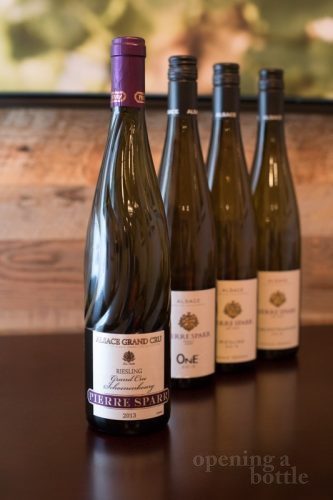I recently profiled two extraordinary dry Riesling from Alsace’s Grand Cru Brand, but two other Grand Cru Riesling are worth noting based on my recent tastings.
On the shoulder of a hillside above the village of Riquewihr — which many consider to be Alsace’s prettiest village — lies the Grand Cru Schoenenbourg. If the “fire” in the Grand Cru Brand comes from the reflective heat of broken granite, then Schoenenbourg reveals a slightly softer side with its nutrient-rich soil and sandy gravel top layer. But these wines do not hold back much. Case in point, this bottle from Pierre Sparr.

I have written about this wine before, and I am an unabashed fan of Pierre Sparr. The 2013 vintage scored just as well as the 2011 vintage, with seemingly a leaner, more acidic profile. If anything, it was perhaps a bit more stunted in finish compared to the grandiose wines of Grand Cru Brand. Still: a high-quality wine worth seeking out.
Another Grand Cru Riesling that caught my attention comes from the Grand Cru Altenberg de Bergheim. Alsace’s geology is chaotic and varied, with this vineyard featuring yet another soil type: red marl-limestone. The soil in the Grand Cru Altenberg de Bergheim is shallow and rich in fossils.
I found an example from this vineyard from Gustave Lorentz, another Alsatian winemaker I have profiled before with their lovely Cremant. This Riesling had the fullest body, and its acidity had the most zing. In fact, at times it was almost too much of a wine, lacking the subtlety and grace found in the two bottles from Grand Cru Brand. Nonetheless, it is better than most dry Riesling on the market, and an intriguing taste of Alsace’s varied terroir.
I should note that these comparisons between Grand Cru vineyards are merely surface-level impressions. All four wines — two here, two in the Grand Cru Brand vineyard story — come from four different vintages, and Riesling is highly prone to vintage variation, so I would hesitate to take these notes as any kind of ranking among the winemakers.
If you are looking to better understand Alsatian Riesling like I am, here are a few suggestions:
- Visit the Wines of Alsace website: It is one of the more detailed and thoroughly researched regional wine websites I’ve come across.
- Taste at home: Compare a Grand Cru Riesling to an Alsace Riesling blend from multiple vineyards, or taste it side-by-side with a German Kabinett Riesling.
- Have a party: Set up a tasting group or have a tasting party. Encourage each person to bring a Grand Cru Riesling and see what differences you note.
Here are my full tasting notes on the two wines mentioned above.
2013 Pierre Sparr Grand Cru Schoenenbourg Riesling

Grand Cru Schoenenbourg AOC, Alsace, France
Grapes: Riesling (100%)
Alcohol: 13%
Ratings: ★★★★ 1/2 (out of five)
• Aromas, Flavors & Structure: ★★★★ 1/2
• Food-friendliness: ★★★★ 1/2
• Value: ★★★
Tasting notes: Further north and above the impossibly scenic town of Riquewihr lies the Grand Cru Schoenenbourg. This vineyard is certainly best known for its Riesling, which tend to be powerful and rich due to its warm microclimate and the gravel topsoil which retains heat.
Aromas recalled lime zest, then honeycrisp apple, honeysuckle and lemon oil. Zingy and ripping with a massive line of acidity running through every sip.
Serving suggestion: Despite its dryness, I thought this was a fitting wine for spicier cuisine such as Verzcruz-style seafood dishes.
Find a bottle of Pierre Sparr Grand Cru Schoenenbourg Riesling
2011 Gustave Lorentz Grand Cru Altenberg de Bergheim

Grand Cru Altenberg de Bergheim AOC, Alsace, France
Grapes: Riesling (100%)
Alcohol: 13.5%
Ratings: ★★★★ 1/4 (out of five)
• Aromas, Flavors & Structure: ★★★★
• Food-friendliness: ★★★★ 1/2
• Value: ★★★
Tasting notes: This wine is the simplest of the three, but nonetheless, a refreshing and energetic Riesling with a lot of potential for aging. Aromas brought to mind golden apples, hawthorn, lime pith and a bit of a saline/briny note reminiscent of the sea. It eventually feels perfumey on the nose. On the palate, its a bit hyperactive at first. The acidity is like a playful puppy who won’t stop bringing a tennis ball to your feet. But eventually it settles into something pleasant and appealing, revealing fleshy textures of stone fruit.
Serving suggestion: Spicy Thai cuisine or Indian curries.



